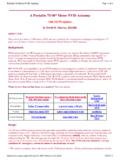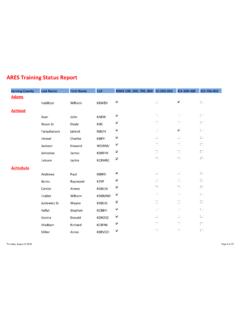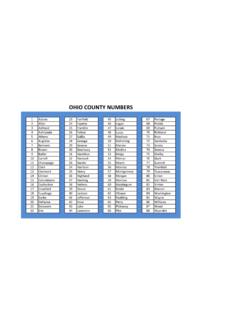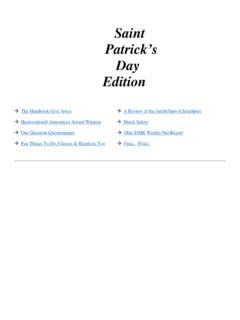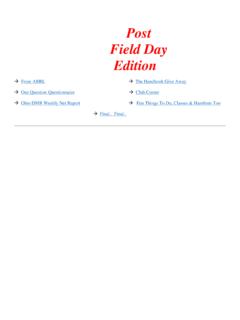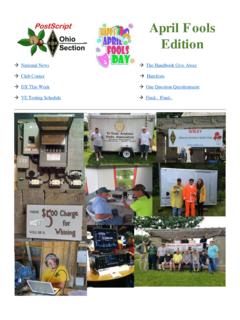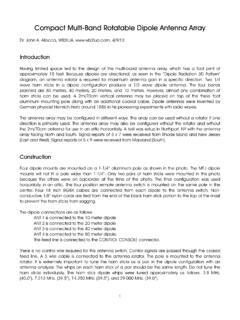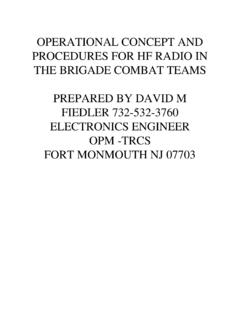Transcription of CARA NVIS Article 3 - arrl-ohio.org
1 Improving the AS-2259 nvis Antenna By N3AE and N3 IDX. Most CARA members just finished making nvis antennas for HF emergency service use on 80 and 40 meters. The antenna design is based on the military AS-2259 with the dimensions shown in Figure 1. Further information can be found at W9 WIS's web site. The cross dipole wire lengths of 38 ft and 25 ft provide for a reasonably small antenna footprint but the resonant frequencies are well outside the 40 and 80 meter amateur bands, requiring the use of an antenna tuner. Figure 1. Figure 1. The antenna was analyzed using EZNEC to determine its basic characteristics and to identify any improvements that could be made.
2 The SWR plot shown in Figure 2 shows the antenna has low SWR only at MHz and MHz. At MHz the antenna has a feed point impedance of - ohms, leading to a very high SWR. The performance at MHz isn't any better, with a feed point impedance of - ohms. The high 40 and 80M SWR, as well as the resonances around MHz and MHz were confirmed on N3 IDX's antenna using an MFJ-259 antenna bridge. Figure 2. While a good antenna tuner may be able to match the antenna on 40 and 80 meters, the SWR on the coax feedline is very high, leading to high losses well beyond the matched loss of the coax itself.
3 A quick check with a transmission line program shows that on MHz, using 100 ft of RG-8X coax, the high SWR adds db of loss on top of the basic db matched loss of the coax. The total 12 db of loss means that your 100 watt transmitter is only getting watts into the antenna. So why does this antenna work for the military? For one thing, the radio is typically right at the bottom of the mast, not many feet away. Also, for the military version (at least the version built by Collins Radio) the mast itself is designed to be a very low loss, large diameter coax transmission line.
4 So what can we do to improve this antenna for 40 and 80M amateur use? One solution is to make the antenna elements look longer electrically by adding loading coils near the center of the antenna. EZNEC has a very nice method to add series impedances in the antenna segments. In this case, we need inductive impedance. A bit of trial and error resulted in the much improved SWR plot shown in Figure 3. At MHz, the SWR. drops to a respectable 2:1. The 40M SWR is even better, dropping to about 1 around MHz. Figure 3. So how do we make the coils? The formula for a single layer closed-wound inductor can be found in the ARRL handbook.
5 K7 MEM has a very nice on-line calculator. The EZNEC derived inductance values were used to build loading coils using PVC pipe for the coil form. The 80M coils use inch pipe (which has an outside diameter of 1 7/8. inches). The 40M coils use 3/4 inch pipe (which has an OD of inches). Insulated 14. gage house wire was used. After some final tweaking to adjust the number of turns to achieve best SWR as measured by the MFJ-259, we arrived at 14 turns for the 40M coils and turns for the 80M coils. The differences between the EZNEC calculated values (19 turns on 40M; turns on 80M) and the final MFJ-259 confirmed values are probably due to errors modeling an antenna this close to the ground, plus the fact that the coil wire leads add length to the overall antenna wire.
6 The coils are close wound on the PVC pipe and anchored by drilling a small hole through the pipe to pass the end of the wire. One end is mounted to a small screw and nut. The coil system easily installs between the antenna's end cap and the current antenna wire system. The 40M coil is shown in Figure 4 and the 80M coil is shown in Figure 5. A. close-up of the antenna with all four coils installed is shown in Figure 6. We hope CARA members have found this Article useful and will take advantage of the improvements for their nvis antennas. Figure 4. Figure 5. Figure 6.
